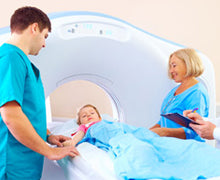
New data seems to put doctors wishing to abide by their promise from the Hippocratic Oath to “do no harm†in a quandary regarding CT scans. That’s because the diagnostic imaging procedure that helps improve clinical outcomes could increase the risk of brain cancer, especially in younger patients.
The results of a new study published in the Journal of the National Cancer Institute suggest that computed tomography (CT) scans, which allow medical professionals to see a three-dimensional image of the scanned area, may increase the risk of brain tumors as a result of the radiation emitted by the machine. The use of CT scans has increased greatly over the past 20 years because the image quality allows for a better medical diagnosis. But that comes at an increased radiation load compared to other tests such as a standard x-ray.
The most common radiation-related malignancies in children and young adults are leukemia and brain tumors. And children are thought to be at a greater risk than adults because of the dosage in relation to their body size and the fact their longer projected life span allows more time for the effects from the exposure to show.
Researchers in the Netherlands wanted to check the incidence of those two conditions as it relates to CT scans from childhood so they tracked 168,394 Dutch children who received one or more CT scans between 1979 and 2012. Because pediatric CT scans are only performed in hospitals, researchers were able to survey hospital-based radiology departments and cross-referenced that data with cancer incidence reports.
The overall incidence of cancer was 1.5 times higher than expected. And for all brain tumors (malignant and non-malignant) the risk quadrupled for the highest dose categories. However, researchers observed no association for leukemia. It is theorized that is because radiation doses to the bone marrow, where leukemia originates, were low.
“Epidemiological studies of cancer risks from low doses of medical radiation are challenging,†said researcher Michael Hauptmann. “Nevertheless, our careful evaluation of the data and evidence from other studies indicate that CT-related radiation exposure increases brain tumor risk. Careful justification of pediatric CT scans and dose optimization, as done in many hospitals, are essential to minimize risks.â€
Researchers were careful to not prescribe a definitive causation because they were not able to determine how many children had to be scanned as a result of their predisposition for developing cancer, which would skew the results.
Click here to read more in the Journal of the National Cancer Institute.



